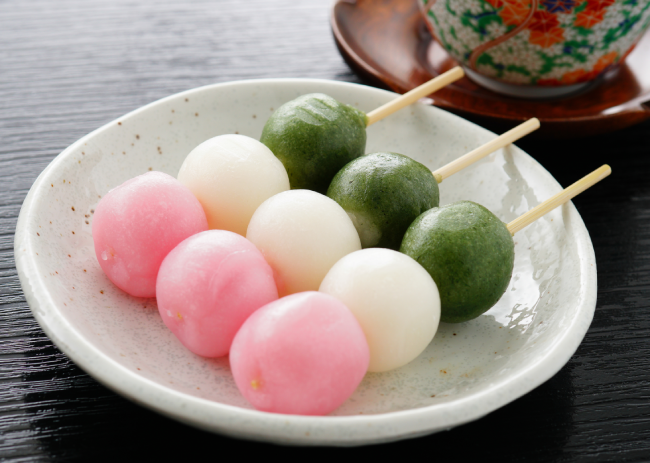
Dango: Step-By-Step Recipe
This Dango Recipe is easy, colourful, sweet and chewy, making it the perfect Japanese dessert to enjoy in spring!
Ingredients
- 1 ⅓ cups Joshinko rice flour without gluten
- 1 ½ cup Shiratamako glutinous rice flour
- ¾ cup powdered sugar (optional)
- 1¾ cup warm water
- 1 tsp matcha powder
- 1 drop of pink food colour
Instructions
- To begin making the Dango, first, put 12 small bamboo skewers in water to soak them. In a mixing bowl, add 200 grams of glutinous sweet rice flour (Shiratamako). Also 150 grams of non-glutinous rice flour (Joshinko). If you want to make it sweeter, add 75 grams of powdered sugar.
- Then add 1 ⅓ cups of hot water and stir with a spoon. Mould the dough with your hands until it is similar in texture to play dough.
- Next, make three equal portions of the dough and place each part into a separate bowl. To make the pink dough, Mix after adding one drop of pink food colouring.
- For the matcha dough, Make a paste by combining 1 teaspoon of water with 1 teaspoon of matcha powder. Then, Add the paste to the dough and mix well. Leave the third bowl of dough white.
- In addition, start with the white dough balls, shape each dough into 20-gramme balls and cook them in boiling water. Once the balls rise to the surface of the water, continue cooking for 2 more minutes.
- Then, repeat the same with the pink and green dough balls after transferring the dumplings. Then transfer it to a dish of ice water with a slotted spoon.
- Finally, thread the dumplings onto the soaked bamboo skewers. Starting with the green dumplings, then white, and finishing with the pink dumplings. You can enjoy Dango as is or topped with sweet soya glaze, matcha paste or a red bean paste.
Notes
- Put the ingredients on the kitchen scale and weigh them. Because the texture of the dough can vary depending.
- Next, use hot water to mix the dough, as this helps to activate the gluten in the flour and create a smooth texture.
- Then, knead the dough until it is similar in texture to play-dough, but a little softer. This will make it easier to shape the dumplings into balls.
- Divide the dough into equal parts before adding the food colouring because this will help to distribute the colour throughout each piece of dough.
- In addition, cook the dumplings in the order of white, pink, and green in boiling water. Do it to avoid the colours staining the water or altering the colour of the dumplings.
- Once you cook the dumplings, transfer them to a bowl of ice water to stop the cooking process.
- Skewer the dumplings in the traditional order of green, white, and pink. Do it to represent summer grass, winter snow, and spring cherry blossoms.
- Finally, serve the Dango with traditional toppings such as sweet soya glaze, matcha paste or red bean paste.